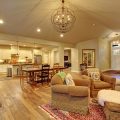1. Understanding Energy-Efficient Lighting Technologies
Today’s homeowners and renters across the U.S. are increasingly interested in ways to save on their electric bills without giving up style or comfort. Energy-efficient lighting has become a go-to solution, thanks to its ability to lower energy costs while still offering a wide variety of attractive design options. Let’s explore the most popular and innovative technologies available today.
LEDs: The New Standard for Efficiency
Light Emitting Diodes (LEDs) have revolutionized home lighting over the past decade. They use far less electricity than traditional incandescent bulbs and last much longer. With improvements in color temperature and dimming capabilities, LEDs now fit seamlessly into any décor, from modern kitchens to cozy bedrooms.
| Lighting Type | Average Lifespan | Energy Usage | Common Applications |
|---|---|---|---|
| Incandescent | 1,000 hours | High | Largely phased out |
| CFL (Compact Fluorescent) | 8,000 hours | Moderate | Kitchens, bathrooms |
| LED | 25,000+ hours | Low | All rooms, outdoor lighting |
Smart Bulbs: Modern Convenience Meets Savings
Smart bulbs are another game-changer in the U.S. market. These LED-based lights can be controlled with your smartphone or smart home system like Amazon Alexa or Google Home. You can set schedules, change colors, and even monitor energy usage—all of which help reduce unnecessary power consumption.
Sustainable Options Gaining Popularity
Alongside LEDs and smart bulbs, sustainable lighting options are also gaining ground. Solar-powered outdoor lights are an affordable way to illuminate gardens and pathways with zero ongoing energy cost. Meanwhile, ENERGY STAR-certified products ensure that you’re choosing fixtures tested for efficiency and reliability.
Main Benefits of Modern Energy-Efficient Lighting:
- Saves money on utility bills year-round
- Lowers carbon footprint—great for eco-conscious households
- Supports creative interior design with various shapes and colors
If you’re ready to upgrade your home’s lighting, these technologies offer a winning combination of cost savings and flexible design options tailored for the American lifestyle.
Balancing Design and Efficiency
Choosing the Right Fixtures for Style and Savings
When it comes to upgrading your home’s lighting, you don’t have to sacrifice style to save on your energy bill. Many modern light fixtures are designed with both aesthetics and efficiency in mind. Look for sleek LED chandeliers, statement pendant lights, or minimalist wall sconces that fit your decor style while offering significant energy savings.
Tips for Blending Energy-Efficient Lighting with Home Decor
- Match Color Temperatures: Choose bulbs with a color temperature that suits each room’s mood. Warm white (2700K-3000K) is cozy for living spaces, while cool white (4000K-5000K) works well in kitchens and bathrooms.
- Layer Your Lighting: Combine overhead lights, task lighting, and accent lamps. This not only boosts energy efficiency but also adds depth and interest to any space.
- Use Smart Controls: Install dimmers, motion sensors, or smart bulbs to customize brightness and reduce unnecessary energy use.
- Select Fixture Finishes: Modern LEDs come in a variety of fixture finishes—from matte black to brushed nickel—that can easily complement your existing design theme.
Comparing Popular Energy-Efficient Bulb Styles
| Bulb Type | Design Appeal | Best For | Energy Savings |
|---|---|---|---|
| LED Edison Bulbs | Vintage/Industrial Look | Diners, Living Rooms, Bedrooms | High |
| Smart LED Bulbs | Modern & Customizable Colors | Living Rooms, Home Offices | High (with scheduling) |
| Recessed LED Downlights | Sleek/Minimalist | Kitchens, Hallways, Bathrooms | Very High |
| CFL Bulbs | Traditional Bulb Shape (Limited Style) | Laundry Rooms, Garages | Moderate to High |
Create Visual Impact Without Wasting Energy
You can make a bold statement by using a dramatic energy-efficient chandelier in the entryway or grouping multiple pendant lights over a dining table. Use reflective surfaces like mirrors or metallic accents to bounce light around the room—this trick maximizes brightness without extra wattage. With today’s lighting technology, it’s easier than ever to highlight your unique taste while keeping utility bills low.
![]()
3. Cost Savings: Short-Term and Long-Term Benefits
Switching to energy-efficient lighting solutions is not just about being eco-friendly—its also a smart way for American families to save money. Let’s break down the upfront costs versus long-term savings, so you can see exactly how these choices pay off in real life.
Upfront Investments: What to Expect
When you first consider upgrading to LED or other energy-efficient bulbs, it might seem like you’re spending more money compared to buying traditional incandescent bulbs. Here’s what you’ll typically pay for each type:
| Bulb Type | Average Cost per Bulb | Lifespan (Hours) |
|---|---|---|
| Incandescent | $1-$2 | 1,000 |
| CFL (Compact Fluorescent Lamp) | $2-$4 | 8,000 |
| LED (Light Emitting Diode) | $3-$8 | 25,000+ |
While LED bulbs cost more upfront, they last much longer and use far less energy.
Long-Term Energy Savings: How Much Can You Save?
The real savings come from your monthly electric bills. Energy-efficient bulbs use less power to produce the same amount of light. Here’s a quick comparison using a typical American household scenario:
| Incandescent (60W) | LED (10W equivalent) | |
|---|---|---|
| Annual Energy Use (for 10 bulbs, hours/day: 5) | 1,095 kWh | 183 kWh |
| Annual Cost (@ $0.15/kWh) | $164.25 | $27.45 |
| Savings per Year | $136.80 | |
This means that by switching just ten bulbs in your home from incandescent to LED, you could save over $130 every year on energy costs alone.
Real-Life Example: The Smith Family in Ohio
The Smiths replaced all 20 of their old incandescent bulbs with LEDs throughout their three-bedroom home. They spent about $100 on new bulbs but saw their monthly electricity bill drop by nearly $12 within the first month. Over one year, that’s an estimated $144 saved—meaning their initial investment paid off in less than nine months! Plus, with LEDs lasting up to 25 years, they won’t be buying replacement bulbs any time soon.
Beyond the Numbers: Added Value for Homeowners
Apart from direct savings, many American utility companies offer rebates or incentives for switching to energy-efficient lighting. This makes your upfront investment even lower and speeds up your return on investment. In addition, having modern lighting can boost your home’s appeal if you ever decide to sell—energy efficiency is a big selling point in today’s market!
4. Choosing the Right Lighting for Each Space
Picking the best energy-efficient lighting for your home isnt just about saving money—its also about creating the perfect look and feel in every room. Here are some easy tips to help you choose lighting that’s both stylish and functional, tailored to each space.
Understand the Function of Each Room
Different rooms have different needs. Think about how you use each space before selecting your lighting. For example, kitchens need bright task lighting, while bedrooms benefit from softer, relaxing light.
Layer Your Lighting
Combining several types of light can enhance both design and function. Use a mix of ambient (general), task (focused), and accent (highlighting) lights to create the right atmosphere.
Room-by-Room Lighting Guide
| Room | Recommended Bulb Type | Color Temperature (Kelvin) | Tips for Ambiance & Efficiency |
|---|---|---|---|
| Living Room | LED or CFL bulbs | 2700K-3000K (warm white) | Add dimmable fixtures for flexibility; use floor and table lamps for coziness. |
| Kitchen | LED bulbs | 3000K-4000K (neutral white) | Under-cabinet lights improve visibility; opt for ENERGY STAR certified bulbs. |
| Bedroom | LED or smart bulbs | 2700K (soft warm white) | Use bedside lamps with low-wattage bulbs; consider smart bulbs for adjustable brightness. |
| Bathroom | Damp-rated LED bulbs | 3000K-4000K (bright white) | Avoid harsh light near mirrors; install layered vanity lighting. |
| Home Office | LED daylight bulbs | 4000K-5000K (cool white/daylight) | Add task lights at your desk; reduce eye strain with even illumination. |
| Outdoor Spaces | Weatherproof LED bulbs/solar lights | 3000K-4000K (neutral white) | Select motion-sensor lights for security; solar options cut energy costs. |
Select Fixtures That Match Your Style
You don’t have to give up style when going green. Today’s energy-efficient fixtures come in a wide range of designs—from modern to farmhouse chic—so you can find something that fits your home’s personality.
Troubleshooting Common Problems:
- If LEDs seem too bright: Try a lower wattage or add dimmers.
- If colors look off: Choose bulbs with a higher CRI (Color Rendering Index) above 80.
- If you want smart controls: Look for Wi-Fi enabled or app-controlled LED bulbs for easy adjustments.
With these simple tips, you can easily select energy-efficient lighting that suits every room’s purpose while keeping your home welcoming and stylish—all without running up your electric bill.
5. Incorporating Smart Technology for Maximum Impact
The Benefits of Smart Lighting Systems
Smart lighting systems are changing the way American homeowners save energy and money, while also making their spaces look stylish and modern. These systems allow you to control your lights remotely, set schedules, and even adjust the brightness or color temperature—all from your smartphone or voice assistant. With smart lighting, you dont have to choose between efficiency and design; you can enjoy both!
How Automation Enhances Convenience and Savings
One of the biggest perks of smart lighting is automation. Imagine never having to worry about leaving the lights on when you leave the house. Automated lighting can be programmed to turn off when a room is empty, or dim at certain times of day to use less energy. This not only saves on your electric bill, but also adds an extra layer of convenience to your daily routine.
Popular Smart Lighting Features in American Homes
| Feature | Benefit | Example Use |
|---|---|---|
| Scheduling | Reduces wasted energy | Lights turn off automatically at bedtime |
| Dimming & Color Control | Personalized ambiance & lower costs | Create a cozy movie night vibe with warm light |
| Motion Sensors | No more lights left on by accident | Bathroom lights that turn off when no one’s there |
| Remote Access | Total control from anywhere | Turn on porch lights before arriving home late |
| Voice Activation | Hands-free convenience | Ask Alexa or Google Assistant to dim living room lights |
Design Flexibility with Smart Lighting Solutions
Smart bulbs and fixtures come in a wide range of shapes and finishes, fitting right into any interior style—from modern farmhouse to mid-century chic. You can highlight artwork, create dramatic accent lighting, or keep things subtle with soft overheads. The best part? You can change up your look anytime without rewiring or buying new fixtures—just adjust your settings in the app.
Getting Started with Smart Lighting in Your Home
If youre new to smart lighting, start simple: swap out standard bulbs for smart LEDs in rooms you use most often, like the kitchen or living room. Pair them with a hub or connect directly to WiFi for easy control. As you get comfortable, expand to other areas and play around with features like scenes and routines. Its an easy upgrade that delivers real savings and style—no electrician required!


